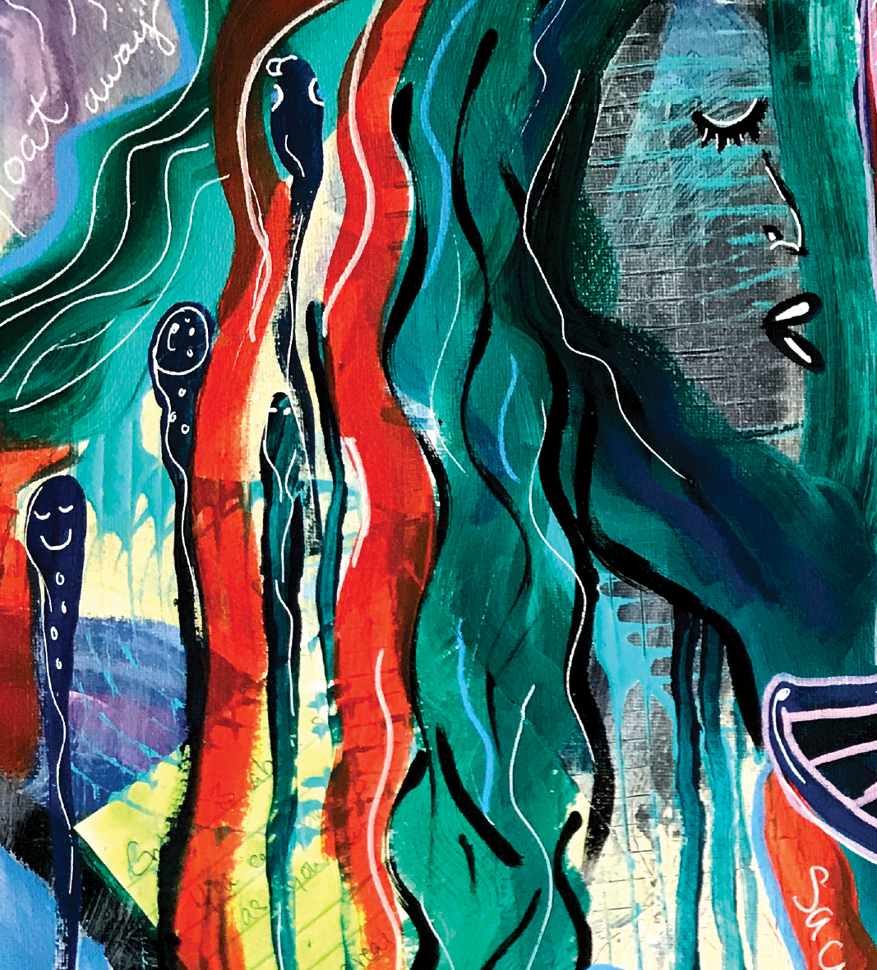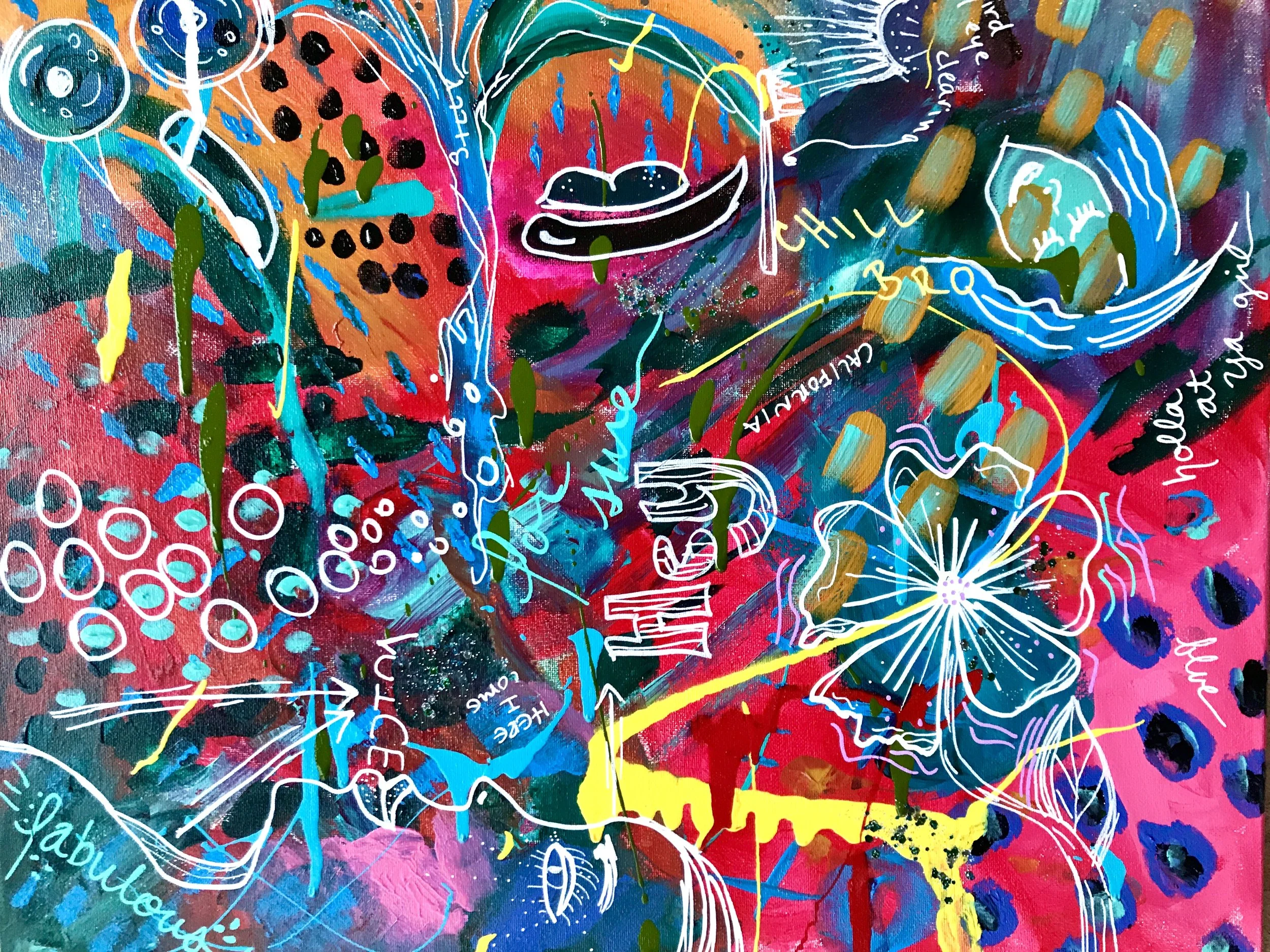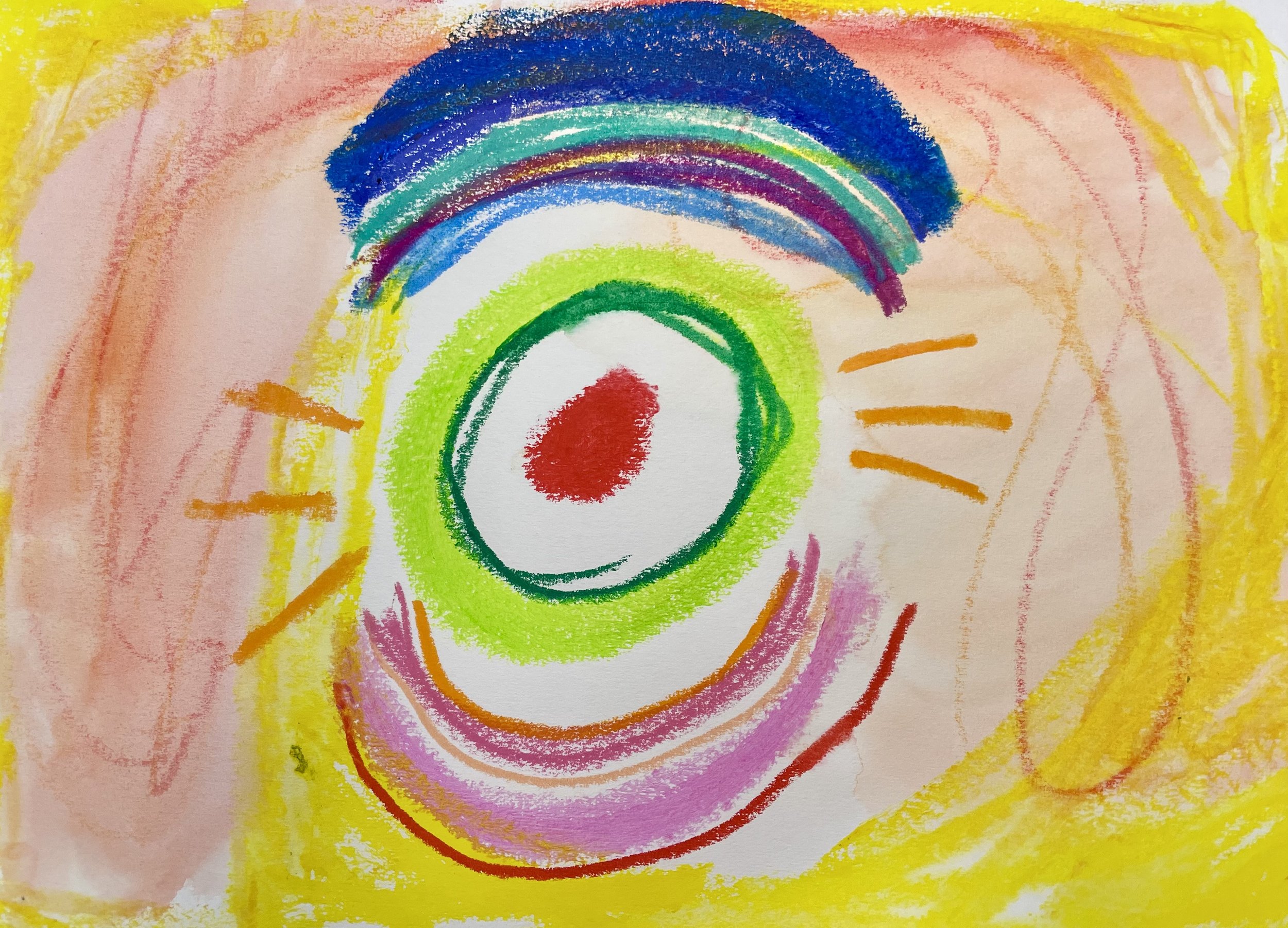What is intuitive art?
Intuition and Art
When I’m talking about my artwork, the first questions I get asked are: What is an Intuitive Artist and what is Intuitive art? Most people are familiar with the concept of abstract art, but Intuitive Art is a fairly new term. Intuitive art is a type of abstract art, but it’s not just abstract art, if that makes sense. Think of abstract art as the big umbrella, and Intuitive Art has its own umbrella underneath it. There are specific strategies and tools used in Intuitive Art that makes it Intuitive versus just “abstract”.
History of Intuitive Art
When you flip through an art history book you can quickly see that as society progresses, our art increasingly becomes more abstract. You could say it started with the Impressionist movement in the late 1800s, when artists like Monet, Manet, Renoir and Degas began sliding just a step or two to the left of realism.
Around that time Henri Matisse also set foot on the scene. Matisse’ work alone is a great example of moving from realism toward abstract. If you want a fun rabithole, google “Henri Matisse, drawing with scissors.” Talk about abstract and unique!
I consider Matisse a hybrid of sorts, bridging the artists of the 1800’s with the new styles of the 1900’s. Along with Matisse, In the 1920’s we began to see the first big movement of abstractism. Artists such as Willem de Kooning, Jackson Pollock and Georgia O’Keefe brought this movement into motion all across the nation.
The Abstract movement gave birth to other new art movements, these even more abstract than the last, known as Pop Art, Abstract Expressionism and Modern Art. One of the most well-known artists from this period is Andy Warhol, made famous by his renditions of Campbell’s soup cans.
Another artist whose work shows the abstract craze of the hippie era is Joni Mitchell, who was famous as both a singer-songwriter, and as an artist. Her artwork very much lends itself to abstract-intuitiveness; mixing her poems, doodles, drawings and paintings all together.
Since Warhol’s success in abstractism during the 60’s, 70’s and 80’s, western art has largely been “modern art” with quirky installations being popular, such as the duct tape banana that went viral in 2019 when it was sold for $120,000. (Another great rabithole to fall down.)
When we observe art history as a whole, we can see that abstract art has become more and more appreciated and enjoyed throughout time. (I’m sure the camera and camera phone had something to do with diminishing the value of a hand-painted portrait.) It only makes sense, then, that Intuitive Art has recently made an appearance as a category of art. Art History experts will tell you that an art movement usually isn’t defined until after the movement has happened. I could be wrong, but my guess is that we are in the middle of the Intuitive Art movement now.
Famous Intuitive Artists
Like an art movement, it’s hard to say who exactly did it first. Artists are human beings and so we are all inspired by one another. However, I believe that Intuitive Art has been made popular by the artist Flora Bowley. Even if she was not the first, she’s certainly been the most successful – publishing several books and hundreds of blog posts, as well as a plethora of courses and classes all about Intuitive Art. Flora’s first book on Intuitive Art, “Brave Intuitive Painting” was published in 2012. Again, this tells us how new the movement is.
Other popular Intuitive Artists include Janet Skates of Tulsa, Oklahoma. (I had the wonderful opportunity to have Janet on The Sparkling Hippie Podcast, we really dove into the techniques and theories around Intuitive Art.)
Another potential Intuitive Artist is Shelley Klammer, who teaches Expressive Arts. Expressive Arts are slightly different from Intuitive Art when you really observe the heart of the practice, but I would definitely put them very close to each other.
Michelle Cassou is another pioneer in intuitive art. Though she does not consider herself an intuitive artist, her point-zero method is very much using the artist’s intuition. Cassou has authored eight books about the process of painting for deep self expression. Check out my interview with Michelle on The Sparkling Hippie Podcast
Definition of Intuitive Art
Intuitive Art, also called Intuitive Abstract Art, is the practice of using your intuition to respond to the canvas, both as an artist and as a viewer. I like to think of Intuitive Art as a two-part process, which I will explain more about soon. First, I would like to share the meaning of Intuitive Art. What makes a piece of art “intuitive”?
In traditional art such as realism, an artist often starts with an end goal in mind. Many sketch out an outline of the painting onto the canvas before they ever begin. Another popular practice is to use a photograph of what the artist intends to paint, as a guide throughout the painting process. Realism is very much focused on the end-result, or outcome of the canvas.
In comparison, Intuitive Art is exactly the opposite. The artist starts with nothing in mind. The goal is to focus on the process, rather than the outcome. This leaves the artist just as surprised at the end as the viewer. Rather than making a loose sketch of what is to be created, the artist simply begins by making marks on the canvas. Once the first marks are there, the artist then responds “intuitively” to figure out how to react next. Whatever colors, shapes or mediums that call to the artist most strongly in that particular moment, are what he or she will use for the next steps.
Most Intuitive Art involves lots of layers and potentially lots of different mediums, which allows it to sometimes fall under the Mixed Media category.
Intuitive Art 2 part Process
As I stated before, I like to think of Intuitive Art as a two-part process. Part one involved the artist and part two involves the viewer. Both parties must utilize their intuition while working on or interacting with the artwork.
The Artist
While working on an Intuitive Art piece, the artist’s goal is to trust the process and lean on his or her intuition to respond to whatever is on the canvas. This method includes choosing colors, creating shapes, marks and symbols in the artwork. For example, if the canvas has orange scribbles all over it, the artist might check in with their own intuition to see what feels most exciting to add next. Perhaps she may want to add blue circles or pink “X’s”. Of course, the response differs from artist to artist and from moment to moment.
The Viewer
When an intuitive artist has finished a piece of work, the interaction and intuition-assessing isn’t over. It is now the opportunity of the viewer to ask his or her intuition a few thought-provoking questions. A viewer might consider a piece by asking the following:
What shapes or colors jump out at me first?
Focusing on one specific shape, ask yourself what this shape might symbolize to you?
What made you choose this shape as a focal point?
How does this particular shape or area of the painting make you feel?
How does the painting as a whole make you feel?
These are only a few examples of the dozens of questions that a viewer of intuitive art might consider. In the following section I’ll share one of my favorite ways for interacting with intuitive art.
How to Use Intuitive Art
As someone who leads many intuitive art workshops, I like to guide my students to use the artwork as a tool for unlocking the voice of their own intuition. A simple way to do that is to first think about a problem that you’ve been having lately. Come up with one specific question about this problem. An example might be, “How do I let go of my resentment towards my father?” or “What do I need to do at work in order to get my next promotion?”
Once you have your question sorted, take a few seconds to hold that question in your heart. You might wish to close your eyes and take a few deep breaths while you do this. When you are ready, open your eyes and look at the piece of intuitive art in front of you. Holding your question in your heart or in your belly, notice what sensations you feel as you look at the painting. Do you feel excited, anxious, exhausted? Notice which parts of the painting pull you in.
After gazing for a few minutes, take time to notice which parts of the painting speak to you. What do you like about it? What do you not like about it? What feelings come up for you?
Then, thinking about the question you asked about your intuition, notice how these things are related. How are the shapes, symbols and the colors in the painting speaking to you? How are they answering the question you asked?
Trust whatever comes up. This is your intuition speaking to you. Try not to judge it too quickly or shut down any seemingly random thoughts. These are all intentional guidance from your higher self. This is the beautiful magic where art and intuition meet.
What is Intuitive Perspective?
Another popular question is, “what is intuitive perspective?” This is a great thing to know about when using intuition and art to receive inspiration and divine guidance. I like to think of our intuition as our voice from divine guidance that lives within us. We all have an intuition, it simply needs to be exercised in order to be strengthened, just like any other muscle in the body. The intuition is a muscle of trust.
Intuitive perspective is your unique inner guidance on a specific topic. Thus your perspective from a higher guidance is in fact, your intuitive perspective. It is very wise to lean into your own intuitive perspective when making decisions and also when going about your day-to-day life. Those “gut instincts” are where miracles come through, but you have to be open and listening for the intuitive voice within.
Intuitive color definition in art
One question I often get asked in an intuitive art workshop is, “how do you know what colors in intuitive art represent?” My answer, of course, is to ask your intuition. As someone who works with colors daily and has thoroughly contemplated each color and its unique meaning for me personally, I have a deep understanding of color definitions as they relate to my life and my art. Most people, however, don’t have this much of a relationship with such a wide variety of colors. Some people tend to associate primary colors with the corresponding chakras – red being the root, orange being the sacral, and so on and so forth. Others guess color meanings using the random bits of color psychology they’ve heard throughout the years. “Oh yes, blue is supposed to be calming, so I think this is a calming painting.”
The truth is that colors can mean different things at different times. There is no color that is necessarily negative or positive. Colors are like people, they have a wide variety of personality and characteristics depending upon the circumstances. Red may look angry if scribbled largely across the page. On a different piece of art red may be a color representing comfort in the shape of a warm, fuzzy blanket.
It’s also important to think about how colors interact with one another. Color definitions can change when one color is next to another or layered on top of another. Shapes and symbols can affect color meaning too.
Lastly, the most important factor for defining color is you, the viewer. Each viewer is coming to the scene with a whole lifetime of perspectives, conditioning, thoughts, opinions, emotions and lessons to learn. We each bring all of that with us when we view a painting. It is impossible to look at a painting objectively – all of our personality, past conditioning and political opinions (not to mention much, much more) will be the lens through which we view a painting. This is why it is so important to ground yourself and try to get out of your analytical brain before you look at a painting. Art viewing requires the right side of the brain, which is typically the lesser-used side of the brain in western society.
Defining the colors in art is entirely up to your perspective, what question you are asking the canvas and how you feel at the moment, along with a thousand other things too. This is another great example of how an intuitive art piece can change each time you interact with it. My own artwork is meant to be rotated, so you may find different messages depending on the orientation of the painting. You’ll also find different messages when you bring different questions to the forefront of your mind while viewing it.
Importance of Intuitive Art
Intuitive art is important because it allows you to understand more about what’s going on with you underneath the surface. It is an opportunity to get out of your overthinking, analytically-inclined mind, and into the juicy, creative, right-side of the brain where your intuition and inner-knowing live. From this space you can discover surprising insights you might not otherwise have discovered.
Intuitive Art can be a powerful healing modality. Many of my classes and workshops guide spiritual entrepreneurs into their inner-selves so that they can uncover what energy is keeping them stuck from moving forward into their next big level of success. Stepping into the other side of the brain through art can be a healing and fun way to access your higher consciousness.
Conclusion + Things to Ponder
What are your thoughts on intuitive art? Would you be interested in taking a workshop to learn more about how to utilize it for your own healing? What other questions or hesitations do you have around using intuitive art?
Drop your thoughts in the comments below.
Want to experience the benefits of Intuitive Art in just 5 minutes?
Download your free activity guide here.
Ready to dive into the world of Intuitive Art?
👇Grab my best-selling digital course now! 👇
Learn more about Intuitive Art with These Blog Articles:





